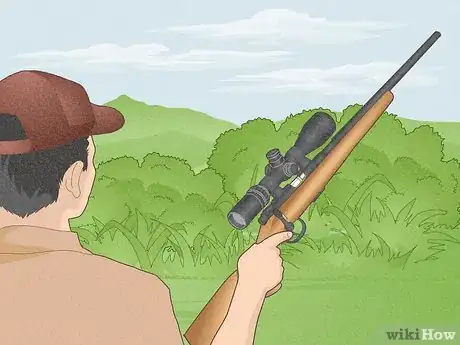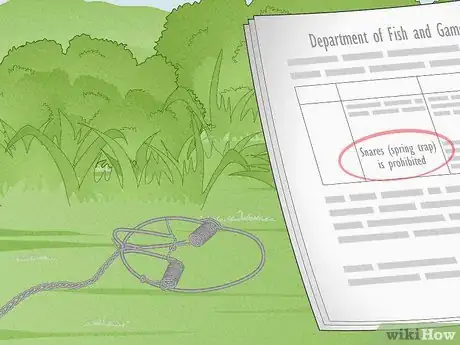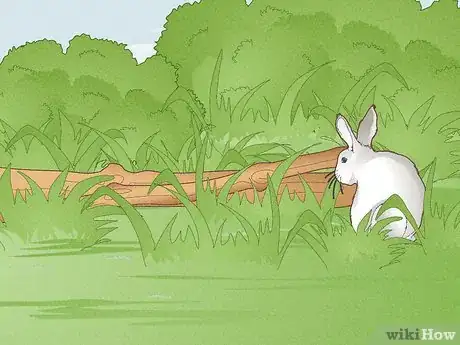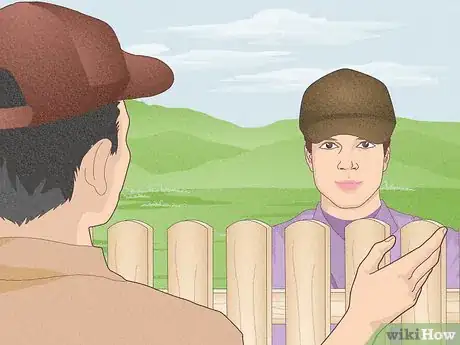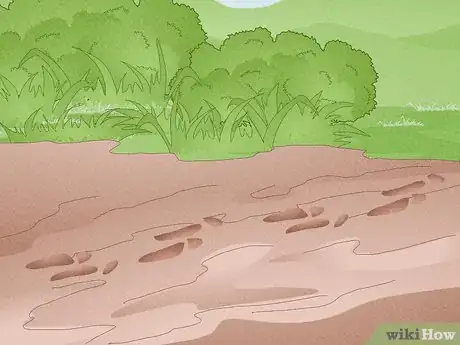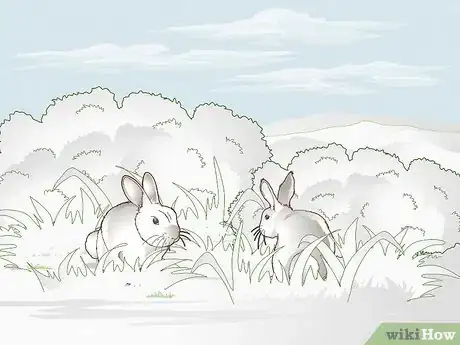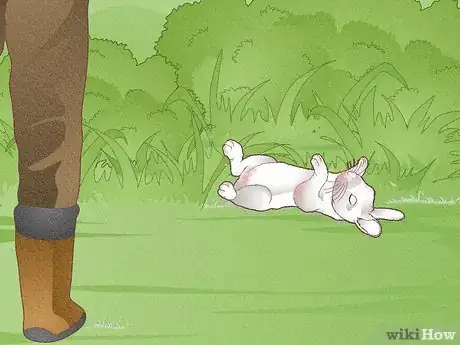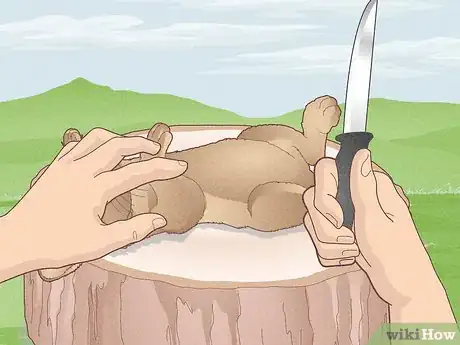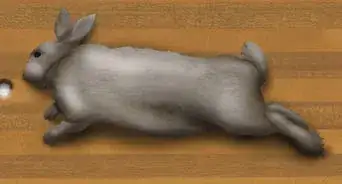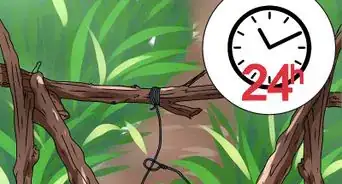wikiHow is a “wiki,” similar to Wikipedia, which means that many of our articles are co-written by multiple authors. To create this article, 33 people, some anonymous, worked to edit and improve it over time.
This article has been viewed 130,378 times.
Learn more...
Hunting wild rabbits is an excellent way for beginners to start hunting, requiring patience, skill, and smarts to get the job done properly. It's important to learn to proper procedures and steps involving in hunting rabbits to make sure that your hunt is legal, safe, and productive. By learning the proper way to license yourself, getting all the supplies and equipment necessary, and how to manage your actual hunt, you'll help to give yourself a better chance of a successful harvest.
Steps
Getting Prepared for Hunting
-
1Get a hunting license. Rabbit hunters need to be licensed with the state in which they're hunting. Usually, this can be done by applying online with the Department of Wildlife, or the Department of Fish and Game. In some areas, you might need to pass a hunting safety or a gun safety course or a quiz before being awarded a license to hunt rabbits.
- Update your license before every new hunting season to make sure that you're up-to-date and legal. In many areas, kids under the age of 14 are allowed to hunt without licensed. Find out the local guidelines in your area, if you're underage, and only hunt with adult supervision.
-
2Wait until the appropriate season. Depending on where you live, harvesting rabbits may be limited to a particular season. Usually, rabbit season lasts from late fall and continues throughout the winter, though in some regions, like California, rabbits may be hunted year round.
- It's also good to figure out whether or not you're permitted to harvest rabbits in designated areas. Often, rabbit hunting is illegal in state or national parks, while in other areas certain areas are permissible for hunting. If you've got a spot in mind, make sure it's legal to hunt there at the time of year you're considering hunting.
Advertisement -
3Learn about bag limits in your area. Usually, you’re not allowed to take more than six rabbits at a time. In some places, though, there’s no limit on small game, including pheasant, rabbit, and other animals. Check the guidelines in your area to be sure.
-
4Learn to identify the rabbits you’ll be hunting. There's more than one kind of rabbit and not all should be hunted. Mexican Volcano Rabbits, for example, are extremely endangered and should never be harvested, though they look much like regular cottontail rabbits. It's important that you learn to identify the appropriate varieties of rabbit you'll be hunting, to keep your hunt legal and safe. Generally, these varieties of rabbits have extremely healthy populations, in the "least concern" category of wildlife preservation:
- White or cottontail rabbits are the most commonly hunted rabbits, and there are several varieties of regional cottontails that vary slightly in appearance. Desert cottontails, for example, have extremely large ears, while swamp rabbits have smaller, sharp faces that resemble rodents more so than rabbits. Unique to the cottontail, however, is it's brownish-black fur and distinctive cloud-white tail. If you see the tail, you can be confident it's a cottontail.
- Jackrabbits are distinctive for their thin ears that stick straight up. Black and white-tailed jackrabbits are common in desert regions and commonly hunted. They have long legs and grow to quite large sizes, making them ideal for hunting in some areas.
-
5Use a hunting rifle of the appropriate size and style. Rabbits are commonly hunted with hunting rifles, shotguns, pistols, and even bow-and-arrow rigs. For many hunters, a .22 hunting rifles is perfectly effective for hunting rabbits, but it can be difficult for inexperienced hunters to make accurate shots with a .22. Rabbits are fast, making a smaller-gauge shotgun sometimes the best tool for the job.
- If you use a shotgun, don’t go any heftier than a 20-gauge. Rabbits are small, meaning that a more powerful weapon constitutes overkill.
- Use shotshells with 6 or 7.5-size steel shot. If you’re planning on eating your rabbits, make certain that you remove the shot and only use steel, never lead.
-
6Find out whether or not hunting with snares is legal in your area. Historically, rabbits were most commonly hunted using baited traps that were used to injure the rabbit and keep it in one place to be harvest later. Nowadays, hunting rabbits with spring traps, or other varieties of snares is illegal in many areas. It's most common to hunt rabbits using firearms, not traps.
- Catching rabbits with live traps is perfectly legal on your own property. If you're going to catch a rabbit, use a live trap.
Finding Rabbits
-
1Learn what and where rabbits eat in your area. Rabbits live in all kinds of habitats, and can flourish and nest in a variety of environments. To learn where best to find rabbits in the area you're hunting, talk to some local hunters to get a sense of heavy-traffic areas that would be safe hunting zones. In general, you'll often find rabbits bedded in or around the following areas:
- Tall grass
- Clover
- Broadleaf fields
- Soy, wheat, and alfalfa
- Gardens
-
2Obtain permission to hunt on property. Wherever you elect to hunt, you need to make sure that you've got permission to hunt and you don't accidentally wander on private property. Wandering around on someone's property toting guns is a good way to get into an awkward altercation, meaning that you should take special care to avoid these entanglements. Have property owners walk you around so you know your borders, or get a detailed map of the area to make sure you don't accidentally wander off property.
- Hunting in state parks and nature reserves also requires lots of extra precaution. Trigger-happy hunters should avoid high-traffic areas.
-
3Hunt early in the morning or right at sunset. Wild rabbits are most active early in the morning and just as the sun is setting. Like many animals, rabbits feed in minimal light, as the sun is going up or coming down, meaning that they'll be most active at those times. The soft light can sometimes make it challenging to find rabbits, but you can learn to train your eye in the right direction to find rabbits in their habitats.
-
4Walk them out. The most common way of hunting rabbits is to walk around slowly and allow the noise of your tromping through the woods to scare them up. Unlike hunting deer, which requires absolute silence, you want rabbits to be able to hear you. You need to be quiet enough to listen for movement, but don't worry about absolute silence.
- A good walking style is to take 10 even paces, then pause and wait 30 seconds. Look to the ground at likely candidates for rabbit nests, and watch closely for signs of movement.
- More often than not, the waiting period of silence after walking and making noise is what will scare up a rabbit. Be patient.
- If you’re hunting with others, stagger your paces so you’re not all walking at once. Wait until you see your buddy pause before you start moving. You can help scare up rabbits toward the other, flushing them out.
-
5Look for tracks. In snow, mud, or other wet conditions, looking for rabbit tracks can be a great way of finding a general area that needs more exploration. If you see a variety of fresh rabbit tracks, double-back on the area, or consider following the tracks to see if you can't find the rabbit's nest, called a "form."
- Forms are often built into shallow areas or bowls, then lined with grass, leaves, and the rabbits' own fur. They can be tough to recognize, so it's usually more effective to keep an eye out for the rabbits themselves.
-
6Leapfrog around. Increasingly, large fields and other hunting regions that were once flush with rabbits are difficult hunting grounds. Some hunters nowadays prefer to jump around between a few different areas, moving more quickly to cover large ground, rather than assuming that you'll scare up a few rabbits in the location that you've chosen. Try to be patient, but also recognize areas that might be too high traffic with hikers or other humans to be a good habitat for rabbits.
-
7Look for their eyes. Cottontails and other rabbits are extremely well camouflaged. Old-timers and experienced hunters know to look for the glinting eye of the rabbit, as opposed to trying to see the whole rabbit. Seeing the rabbit before it sees you can help you get set and train your gun before the rabbit takes off.
- Sometimes, the dark eye can stand out against the background, especially if it's snowy. Keep an eye out for the dark glisten of the rabbit's eye.
-
8Enlist the help of a good hunting dog. Four-legged hunting buddies are excellent for scaring up rabbits and helping to flush them back toward you. Beagles, in particular, make excellent rabbit hunting dogs, letting loose with loud, piercing yowls when they scare up a clutch of rabbits. If you're a dog person, consider making use of a hunting dog.
- Dogs can also be used to track injured rabbits and retrieve them. Using dogs in rabbit hunting makes the whole process less tiring and a whole lot easier. A properly trained hunting dog can drastically increase your haul.
Hunting Safely
-
1Use the appropriate safety gear. Anytime you're out hunting, you need to be extremely careful and always make the safety of you and everyone in your hunting party the number one priority. Every time you hunt rabbits, make sure that you bring the following things:
- Blaze orange clothing. Even if you want to incorporate some camouflage into your hunting gear, you need to stand out from the other hunters in your party, and other parties who might be out looking for rabbits. Blaze orange hats, vests, and other gear is commonly available at sporting goods stores and it's essential for any hunting trip.
- Ear plugs and safety glasses should be worn every time you're shooting. Invest in a good pair of each and use them each time you're using a firearm.
- Heavy clothing, long shirt sleeves and pants are good for keeping your protected from the elements, and from sharp brambles or other obstacles you might encounter while out in the field.
- Bring plenty of water, some emergency supplies, and first-aid, especially if you're going to be traveling way out in the field, or will be hunting over the course of multiple days.
-
2Spread out with your hunting buddies. If you’re hunting in a group, you need to be especially careful about keeping track of all the other members of your hunting party. Hunting accidents are common, but the proper safety measures and presence of mind will keep tragedies from becoming a part of your next hunt. Anytime you're hunting with a group, keep in mind the following guidelines:
- Everyone should be at least 50 feet (15.2 m) apart, far enough to make shots safe and accurate in the space allowed, but close enough to be able to see one another.
- Communicate effectively. Keep talking, or signaling to one another effectively while you're out. If you're going to take a shot, you need to call it, shouting "Mine" or using some other designated signal.
- Never shoot parallel to the ground. Rabbits are on the ground, which means your gun barrel needs to be pointed downward at all times. Under no circumstances should you be firing a weapon up in the air or parallel with the ground, unless you want to injure someone. Don't do it.
-
3Learn to recognize the signs of disease. Unfortunately, rabbits are commonly afflicted with bacterial infections and diseases, meaning that you need to be aware of any outbreaks in the area in which you're hunting, and learn to recognize the signs of tainted meat, especially if you plan on eating the rabbits you harvest.
- Rabbits infected with Tularemia, a common disease affecting small game populations, will act strangely. Rabbits will appear lazy and behave strangely, walking slowly and having delayed reactions. This is more common in extremely hot weather.
-
4Field dress your rabbits within a few hours of harvesting. Depending on your situation, the environment, and the number of rabbits you've collected, you may want to dress out the rabbit right away, or wait until you've gotten home, or back to camp. In cold weather (around 50 degrees F), rabbits will be fine for several hours. Since most rabbit seasons are during this time of year, it's most common to wait to dress rabbits until later.
- To field dress a rabbit, you'll need a sharp hunting knife and your hands. Start by making small cuts around the "ankle" bones of the rabbit to remove the feet, then making a small slit across the back of the rabbit. Grab the fur firmly and pull it in opposite directions, slipping the fur off like a jacket. It should come off quite easily.
- When the fur is bunched around the rabbit's neck, you can use your knife to remove the head, or twist it off firmly and discard. Use your knife to make a small incision between the groin and the ribcage of the rabbit, being careful not to puncture the cavity.
- Hold the rabbit with the feet pointing down and use your finger to hook the entrails out and down. They should fall out easily.
- Wash the cavity of the rabbit and dry it thoroughly. Once the meat is cooled to room temperature, it should be refrigerated below 50 F as soon as possible. The meat should keep for up to a week.
-
5Check in with the game warden if necessary. Depending on where you've been hunting, you might need to safe some of the fur, or leave part of the rabbits intact for examination before you're allowed to take it home. Make sure you familiarize yourself with the regulations in your area to keep in full compliance.
Community Q&A
-
QuestionHow do I cover my scent?
 Community AnswerUnlike deer or large game hunting, you are not so concerned with scent. Remember, you want to flush rabbits. When possible, walk or flush into the wind in order to avoid rabbits hiding before you arrive. You want to startle them.
Community AnswerUnlike deer or large game hunting, you are not so concerned with scent. Remember, you want to flush rabbits. When possible, walk or flush into the wind in order to avoid rabbits hiding before you arrive. You want to startle them. -
QuestionHow old do I have to be to start?
 Community AnswerThere is not a set age for starting hunting. If you are young, you need to have a parent or guardian with you.
Community AnswerThere is not a set age for starting hunting. If you are young, you need to have a parent or guardian with you. -
QuestionCan I hunt rabbit with a bow and arrow?
 Community AnswerYes. The bow tension should be at least 40 pounds, and don't use big, broad heads, as they are overkill for rabbits. Be aware that hunting a rabbit with a bow and arrow may not be legal in your country. For example, in the UK it is illegal to hunt rabbits (and all other species) with a bow and arrow. Legality depends on the country you are in.
Community AnswerYes. The bow tension should be at least 40 pounds, and don't use big, broad heads, as they are overkill for rabbits. Be aware that hunting a rabbit with a bow and arrow may not be legal in your country. For example, in the UK it is illegal to hunt rabbits (and all other species) with a bow and arrow. Legality depends on the country you are in.
Warnings
- Even a low-velocity .22 caliber gun can inflict a fatal wound.⧼thumbs_response⧽
- Be sure to wear blaze orange so you are visible to other people that may be hunting in the area.⧼thumbs_response⧽
- Let someone know your agenda and where you plan on hunting.⧼thumbs_response⧽
Things You'll Need
- A gun
- An adult if underage
- A hunting license
- Ammo
- A bag to carry rabbit carcass
- Emergency supplies
- Food and water
About This Article
The best time to hunt rabbits is at sunrise or sunset, since wild rabbits are more active at these times. To find the rabbits, check areas with tall grass or broadleaf fields, or ask other local hunters. If the area is wet, muddy or covered in snow, look out for any rabbit tracks that could lead you to the nest. Alternatively, if you can’t find any tracks, look out for the glinting eye of a rabbit, this will help you spot any that are well-camouflaged, like cottontail rabbits. For more tips, like what equipment you should use to hunt rabbits, keep reading!




